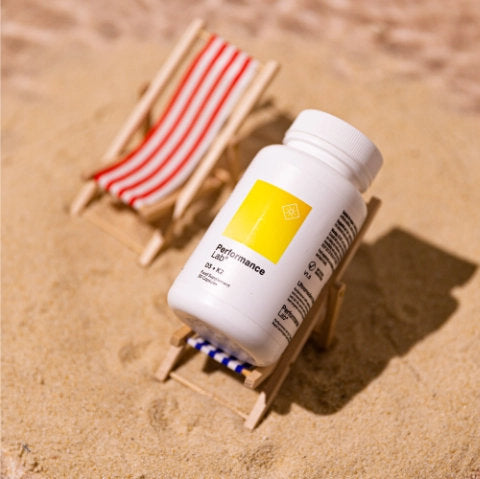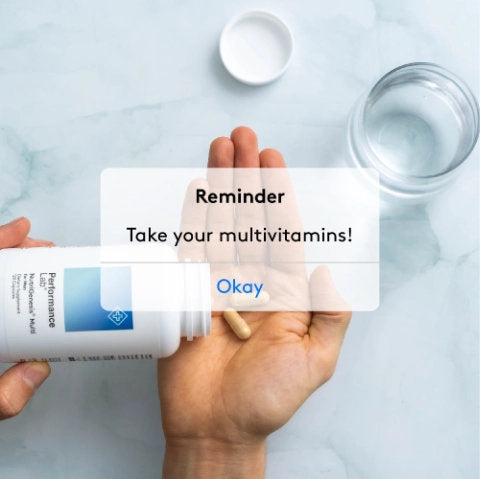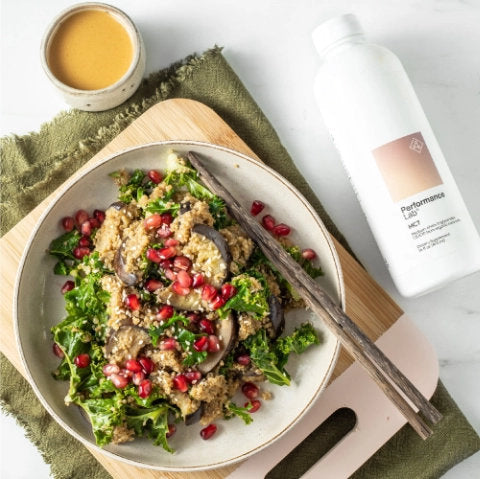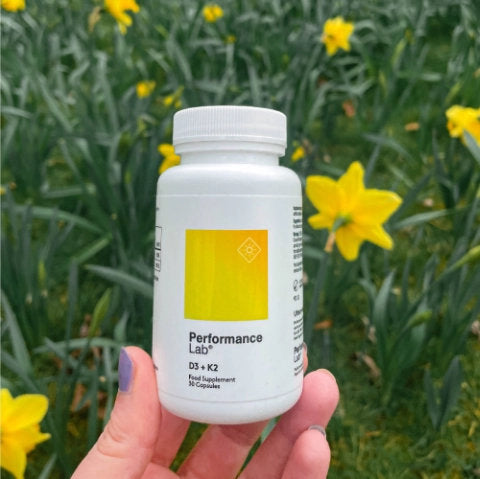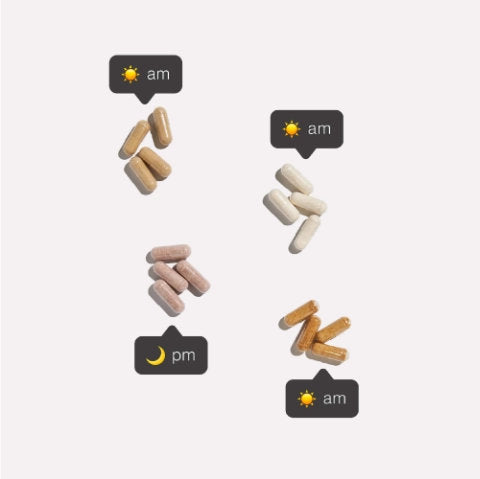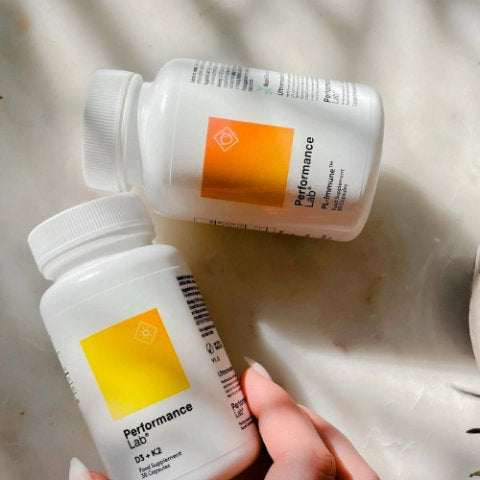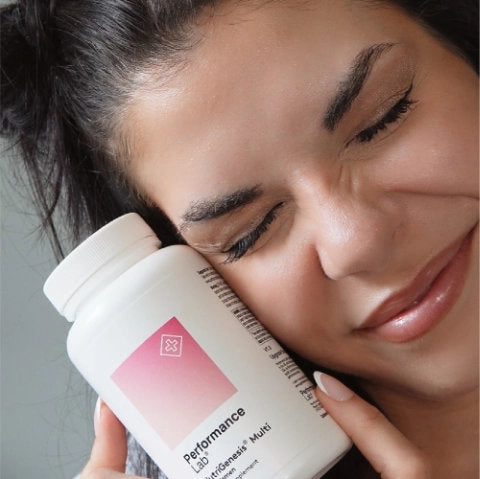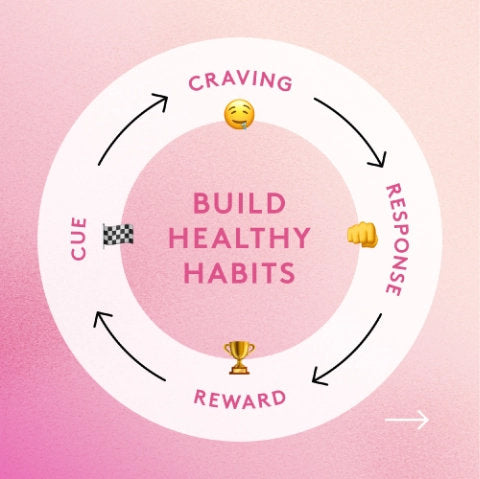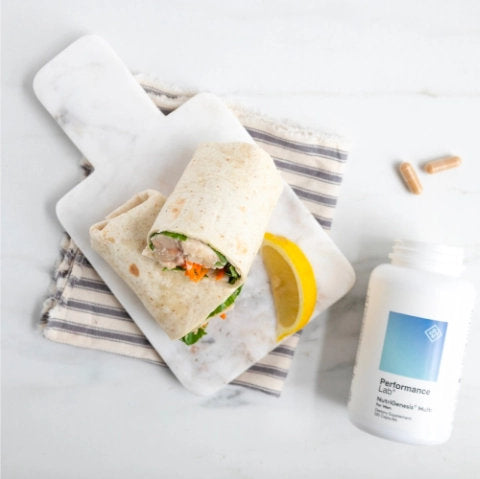Iron is one of the most abundant minerals on earth but happens to also be one of the most deficient among the population, especially women.
It’s a major component of hemoglobin, a protein that transports oxygen to tissues of the body, as well as myoglobin, a protein that carries oxygen to your muscles.
Iron is also essential for brain health, growth and development, hormone synthesis, immune function, and muscle metabolism.
While iron is widely available in both animal and plant food sources, most people struggle to get enough due to insufficient dietary intake, poor absorption, or increased needs. So, when you’re running low on this important mineral, what’s a girl to do?
Answer: you turn to the best multivitamin with iron. You’re looking at the purest, cleanest, most effective women's multivitamin on the market specifically formulated for women’s needs.
In this article, we’re breaking down everything you need to know about the importance of iron for women and where you can find it.
The Best Women's Multivitamin With Iron: Performance Lab NutriGenesis® Multi for Women

For anyone looking to achieve optimal health and performance, fulfilling your daily intake of essential nutrients is important.
And while you may turn to vitamin supplements for extra support, any old store-bought brand isn’t going to cut it to get your fill of key nutrients —you need more.
Performance Lab NutriGenesis® Multi for Women is unlike any other women's multivitamin supplement on the market. Whether inside the gym or not, suboptimal nutrition has a major impact on your performance.
Because we can’t always rely on diet to provide all the nutrients we need in the proper amounts, NutriGenesis® Multi is designed to restore nutrient levels and protect against a deficiency. As a result, you’re getting healthy cell performance across all body systems.
Unlike most conventional women's multivitamins that have improper nutrient ratios and poorly bioavailable forms, NutriGenesis® vitamins and minerals are bioengineered with cofactors that boost absorption and maximize benefits.
NutriGenesis® Multi supplies 100%+ DV of 17+ essential vitamins and minerals, all tailored specifically for female needs.
Key benefits
- Foundational nutritional support for healthy whole-body biological performance
- Supports daily vitality and long-range overall health
- Customized for women with gender-specific dosages and hormonal support
- Complexed with absorption-enhancing cofactors; no synthetic or isolated nutrients
- Supplies at least 100% Daily Value of 17+ essential vitamins and minerals
Key features
- Nutrition technology innovation: NutriGenesis® vitamins and minerals
- Complexed with absorption-enhancing cofactors; no synthetic or isolated nutrients, artificial flavors, or colors
- Probiotic-cultivated NutriGenesis® + prebiotic-infused NutriCaps® for digestive comfort
The Importance Of A Daily Multivitamin
You’ll hear a lot of people say that taking a multivitamin is pointless because you should be able to get everything you need from food.
While we’d love to agree with that, the fact of the matter is that regardless of what kind of diet you follow, it can be difficult for your body to obtain everything it needs all the time from food.
Every diet has its nutritional gaps, be it paleo, keto, vegetarian, vegan, carnivore, or what have you. On top of that, there are external factors outside of diet like genetics, health status, and age that can all influence nutrient absorption.
With that said, let’s dig into five of the main reasons why taking a multivitamin is important.
Lifestyle and diet factors
Certain populations may have different intake needs than others.
For example, people who exclude specific foods from their diets—for example, vegans and vegetarians who don’t consume animal products—may require a higher intake of specific nutrients compared to people who regularly get them from food.
For female athletes or anyone engaging in strenuous activity, balancing nutritional needs is important. While the requirements for what vitamins and minerals they need are the same as the rest of the population, the amounts can differ due to depletion as a result of strenuous physical activity.
For example, exercise is known to reduce levels of the B vitamins and magnesium, and the need for specific antioxidants may be heightened after exercise, as well 1.
Dietary intake
Our bodies rely on a specific intake of vitamins and minerals daily for optimal function.
While there are a few vitamins that can be produced in the body, most of them cannot, which means they must be supplied through diet. And the reality is that most people don’t consume enough of the nutrients their body needs.
NHANES (National Health and Nutrition Examination Survey)—one of the most comprehensive nutritional databases in the world—has looked into the prevalence of nutritional deficiencies among the US population and zeroed in on some of the key missing nutrients 2:
- Vitamin B6
- Iron
- Vitamin D
- Vitamin C
- Vitamin B12
Other less common deficiencies included vitamin A, vitamin E, and folate (B9).
Dietary restrictions can also complicate the matter. There is no single food that supplies all of the essential vitamins and minerals.
So, when you’re cutting out foods that are the main source of one nutrient, you have to make up for it elsewhere, generally through a good women's multivitamin supplement.
For example, except for mushrooms and nutritional yeast, vitamin B12 is only naturally found in animal products. If you’re someone who doesn’t include animal foods in your diet, you have to be supplementing with B12 to avoid a deficiency.
Age
Age can also play a role in nutrient intake. In general, total energy intake tends to decrease with age by as much as 1000-1200 calories in men and 600-800 calories in women, which can directly result in low nutrient intake.
For specific nutrients, it’s estimated that older Americans consume only one-fifth to one-third of the recommended dietary intake 3. On top of that, changes in nutrient absorption capabilities also change with age, which further interferes with levels.
But then we also have specific age groups that may need more of certain nutrients. If you’re going through menopause, you may need a little more support for bone health from calcium, vitamin D, and magnesium.
Pregnant? You’ll need to boost your intake of choline and folate. Heavy periods? Try getting more iron. Your nutrient needs change throughout your life and you need a multivitamin that grows with you.
Genetics
Your genetics can also influence your nutrient status by affecting how your body processes specific nutrients.
This is an important area to look at because certain genetic disorders can also interfere with how the body absorbs and utilizes nutrients. For example, having the MTHFR genetic mutation means that you can’t effectively and efficiently utilize folic acid, the synthetic form of folate or vitamin B9 4.
Folate is not only essential during pregnancy, but it’s required as a cofactor for several biochemical reactions supporting optimal health. That’s why people with this genetic polymorphism opt for methylated forms of certain vitamins.
That’s also why knowing your genetic makeup is important to supporting your individual nutritional needs and choosing the right dietary supplements.
Intake vs. use
Eating a healthy diet may fulfill your body’s requirements for essential vitamins and minerals, but some vitamins function in a pair, and if you’re not getting enough of the other half, it doesn’t operate to its full potential.
Simply put, sometimes vitamins work better together.
Take calcium, for example. Calcium is essential for supporting bone health, but for it to function effectively, it also requires sufficient levels of vitamin D, magnesium, and vitamin K 5. These three nutrients act as the co-stars for calcium.
So, while you may be getting enough calcium through your diet, having a good multivitamin also helps to ensure you’re consuming enough of the other nutrients that calcium relies on to be a superstar.
Another power duo is vitamin C and iron. While the body can easily absorb heme-iron derived from animal foods, non-heme iron from plant foods is much more difficult to absorb. However, when you throw in vitamin C, it can enhance the absorption of iron 6.
What You Need To Know About Iron
Now that you know why having a good multivitamin in your stack is important, there’s one specific nutrient we want to give some love—iron.
Most people focus on the “core” nutrients like vitamin D, vitamin C, magnesium, zinc, and the like, but don’t think twice when it comes to lesser-known nutrients like iron.
But why do you need iron?
Erythropoiesis
The process of red blood cell formation heavily depends on iron levels.
Sufficient levels of iron are essential for the proper function of hemoproteins like hemoglobin, which is involved in the transport and binding of oxygen; cytochromes, which function in the mitochondrial electron transport chain and metabolism; and catalases and peroxidases that play a role in redox reactions 6, 7.
On top of that, metalloproteins that contain iron are required during DNA synthesis, gene regulation, cell proliferation and differentiation, steroid hormone synthesis, drug metabolism, and immune function.
Insufficient iron intake can result in the suppression of erythropoiesis by stimulating the IRP–HIF2α axis to reduce the production of erythropoietin, which subsequently impacts red blood cell formation 8. As a result, iron-deficiency anemia can develop.
Brain function
Although iron may not be the go-to nutrient for supporting brain health, it is essential.
It’s involved in several processes fundamental to the brain such as oxygen transport, DNA synthesis, mitochondrial respiration, myelin synthesis (nervous system), and neurotransmitter synthesis and metabolism 9.
Abnormal iron homeostasis can result in cellular damage through the production of free radicals that induce damage to lipids, proteins, carbs, and DNA.
While iron is essential for proper brain function, excessive accumulation of iron can be toxic. High levels of iron in the brain can induce oxidative stress by generating free radicals that damage DNA. Disruptions to iron homeostasis can also affect the function of mitochondria, which can accelerate the progression of neurodegenerative mechanisms 9.
Long story short, abnormal iron homeostasis can contribute to the development and progression of several neurodegenerative diseases, including Alzheimer’s, Parkinson’s, MS, Frederich’s ataxia, Huntington’s, and restless legs syndrome.
Healthy immune system
Cells of the immune system also rely on sufficient levels of iron to perform optimally.
Iron is required for the proliferation and maturation of immune cells, especially lymphocytes, which are involved in generating a specific response to infection 10.
Although the role of iron in the immune system isn’t completely understood, it’s well-established that iron deficiency increases susceptibility to infection, while iron overload also increases the risk of infection 11. It's all about balance.
Energy
Iron may not contribute directly to energy production but looking at iron levels could explain fatigue, even without diagnosed anemia.
This is because of iron’s role in oxygen transport; insufficient supply of oxygen to tissues can result in suboptimal function and subsequently fatigue. This is especially common for menstruating women.
A 2012 study on the effects of iron supplementation in nonanemic menstruating women with fatigue found that taking an iron supplement improved their score on the Psychological Scale for fatigue by a whopping 47.7% compared to the group taking a placebo who saw an increase of 28.8% 12.
Another study looked at women 18-52 with fatigue and found that 80mg of iron daily resulted in greater improvements in fatigue 13.
Importance Of Iron For Women
While iron is important for all women, it's especially important for women of menstruating age and those going through menopause, and even more so if you’re following a plant-based diet that excludes red meat and/or animal products.
Despite being one of the most abundant elements, iron deficiency is one of the more common nutrient deficiencies globally and disproportionately affects women compared to men 6. It’s estimated that roughly 1/3 of the population is anemic, largely due to insufficient iron intake.
Women of childbearing age who are menstruating are especially vulnerable to iron deficiency due to loss in menstrual blood, and when combined with low dietary iron intake, it can easily deplete stores 6.
Iron intake for women is 18 mg/day, which is more than double that of men (8 mg/day) 14. On top of that, pregnancy also increases the need for iron, increasing recommended intake to 27 mg/day.
However, although iron is an essential mineral, too much of it can be toxic because it generates free radicals that can accumulate in the brain.
Symptoms of iron deficiency may not be apparent immediately, but they can be divided into three distinct stages 6:
- Mild iron deficiency: Normal formation of iron-dependent proteins
- Marginal iron deficiency: Iron-dependent protein formation is compromised by erythropoiesis and hemoglobin synthesis is normal
- Iron deficiency anemia: Compromised hemoglobin production resulted in erythrocytes that are misshapen, small, and hypochromic (pale)
For pregnant women, iron requirements increase to support the growing fetus and placenta, as well as increase maternal red cell mass. Prenatal iron deficiency can lead to several adverse outcomes, including 15:
- Low birth weight
- Low gestational age size
- Preterm birth
- Need for blood transfusion for mother
- Postpartum hemorrhage
- Long-term neurocognitive effects throughout childhood
Signs And Symptoms Of Iron Deficiency
If left untreated, iron deficiency can progress to iron-deficiency anemia (IDA), which means that your blood cells are abnormally shaped and cannot carry sufficient amounts of oxygen to support normal tissue function.
As a result, you start to experience symptoms like:
- Fatigue
- Low energy
- Shortness of breath
- Difficulty concentrating
- Increased illness susceptibility
- Poor body temperature regulation
- Pale skin
- Heart palpitations
- Headaches
- Sore and swollen tongue
- Loss of taste
- Hair loss
- Pica (cravings for non-food items like dirt)
- Mouth sores
- Spoon-shaped nails
- Restless legs syndrome
Other Sources Of Iron
While you can meet your daily intake of iron through NutriGenesis® Multi, including animal foods in your diet is another way to load up on heme iron.
Keep in mind that while the body can absorb non-heme iron, it’s much less bioavailable than heme iron.
Here are some of the best iron-rich foods:
- Heme iron
- Shellfish
- Organ meats (liver, kidneys, brain, heart)
- Red meat
- Turkey
- Fish
- Eggs
- Non-heme iron
- Spinach
- Legumes (lentil, chickpeas, beans)
- Pumpkin seeds
- Quinoa
- Broccoli
- Tofu
- Dark chocolate
Final Thoughts
Dietary supplements containing iron are an important component of a healthy and balanced diet. Because several factors can interfere with iron levels, keeping levels up with a good whole food multivitamin is important to support overall health and well-being.
References
- Marriott, BM. The Effect of Exercise and Heat on Mineral Metabolism and Requirements. In Nutritional Needs in Hot Environments: Applications for Military Personnel in Field Operations. National Academies Press (US). 1993. Jan:117-35.
- https://www.cdc.gov/nutritionreport/pdf/4page_%202nd%20nutrition%20report_508_032912.pdf
- Wakimoto P, Block G. Dietary intake, dietary patterns, and changes with age: an epidemiological perspective. J Gerontol A Biol Sci Med Sci. 2001 Oct;56 Spec No 2:65-80.
- Vidmar Golja M, Šmid A, Karas Kuželički N, Trontelj J, Geršak K, Mlinarič-Raščan I. Folate Insufficiency Due to MTHFR Deficiency Is Bypassed by 5-Methyltetrahydrofolate. J Clin Med. 2020;9(9):2836.
- Price CT, Langford JR, Liporace FA. Essential Nutrients for Bone Health and a Review of their Availability in the Average North American Diet. Open Orthop J. 2012;6:143-149.
- Coad J, Pedley K. Iron deficiency and iron deficiency anemia in women. Scand J Clin Lab Invest Suppl. 2014;244:82-9; discussion 89.
- Kim A, Nemeth E. New insights into iron regulation and erythropoiesis. Curr Opin Hematol. 2015;22(3):199-205.
- Kim A, Nemeth E. New insights into iron regulation and erythropoiesis. Curr Opin Hematol. 2015;22(3):199-205.
- Ward RJ, Zucca FA, Duyn JH, Crichton RR, Zecca L. The role of iron in brain ageing and neurodegenerative disorders. Lancet Neurol. 2014;13(10):1045-1060.
- Soyano A, Gómez M. Participación del hierro en la inmunidad y su relación con las infecciones [Role of iron in immunity and its relation with infections]. Arch Latinoam Nutr. 1999 Sep;49(3 Suppl 2):40S-46S.
- Cherayil BJ. Iron and immunity: immunological consequences of iron deficiency and overload. Arch Immunol Ther Exp (Warsz). 2010;58(6):407-415.
- Vaucher P, Druais PL, Waldvogel S, Favrat B. Effect of iron supplementation on fatigue in nonanemic menstruating women with low ferritin: a randomized controlled trial. CMAJ. 2012;184(11):1247-1254.
- Low MS, Speedy J, Styles CE, De-Regil LM, Pasricha SR. Daily iron supplementation for improving anaemia, iron status and health in menstruating women. Cochrane Database Syst Rev. 2016 Apr 18;4:CD009747.
- Trumbo P, Yates AA, Schlicker S, Poos M. Dietary reference intakes: vitamin A, vitamin K, arsenic, boron, chromium, copper, iodine, iron, manganese, molybdenum, nickel, silicon, vanadium, and zinc. J Am Diet Assoc. 2001;101:294-301.
- Malinowski AK, Murji A. Iron deficiency and iron deficiency anemia in pregnancy. CMAJ. 2021;193(29):E1137-E1138.

